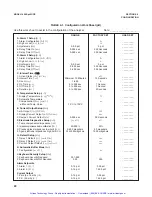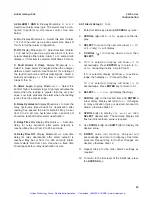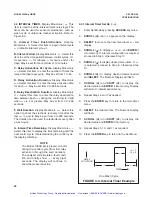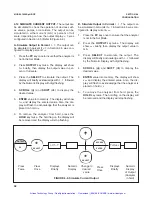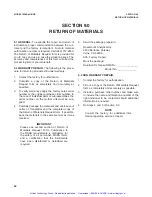
33
MODEL 1054B pH/ORP
SECTION 5.0
START-UP AND CALIBRATION
SECTION 5.0
START-UP AND CALIBRATION
5.1 START-UP AND CALIBRATION.
Calibration and
operation of the Model 1054B should begin only after
completion of configuration of the analyzer. The sen-
sor must be wired to the Model 1054B for calibration.
5.2 TEMPERATURE CALIBRATION.
For accurate
temperature correction, the temperature reading may
need adjusting. The following steps should be per-
formed with the sensor in a grab sample or in the
process. For the best accuracy, the standardization
should be performed at or near the process tempera-
ture.
1.
Observe the analyzer temperature reading by
pressing the
TEMP
key. Allow the reading to sta-
bilize to insure that the sensor has acclimated to
the process temperature.
2.
Compare the reading to a calibrated temperature
reading device. If the reading requires adjusting,
proceed to Step 3.
3.
Press the
TEMP
key then the
SELECT
key to
correct the temperature display. The analyzer will
display
AdJ
briefly, then the Numeric Display will
show with digit flashing.
4.
SCROLL
(
é
) and
SHIFT
(
ç
) to key in the correct
value and
ENTER
it into memory. Proceed to
Section 5.3.
5.3 BUFFER CALIBRATION (1054B pH only).
The
two buffer calibration will calculate the slope (efficien-
cy) of the pH sensor and standardize the reading on
the second buffer (computed slope limits: 47.3 to 59.9
mV/pH). The analyzer has been set at the factory for
automatic calibration. If the software setting has been
changed to disable this feature in Section 4.9 proceed
to Section 5.3.2. Otherwise, proceed to Section 5.3.1.
5.3.1 Automatic Calibration
1.
Press the
HOLD
key twice to place the analyzer in
hold.
2.
Obtain two buffer solutions with values at least two
pH units apart. Unopened buffers have a shelf life
of about a year and once opened should general-
ly not be reused because of possible contamina-
tion.
3.
Shake the sensor down to remove entrapped air
bubbles from the glass electrode tip.
4.
Place the sensing portion of the pH sensor into a
beaker containing the first buffer solution. Allow
the pH reading to stabilize. This may take several
minutes, as the pH sensor may need to cool down
to the buffer temperature. If you don't wait long
enough you may get a slope error.
5.
Press the
CAL
key.
Ab1
will flash briefly, followed
by a flashing pH buffer value at 25°C (If
Ab2
appears, press the
CAL
key again for
Ab1
).
6.
If the value displayed is not the value of your
buffer at 25°C (see Section 4.9) press the
SCROLL
(
é
) key until your choice appears.
ENTER
the value.
7.
Remove the sensor from the buffer, then rinse and
dry it. Place it in the second buffer. Allow the pH
reading to stabilize. This may take several min-
utes, as the pH sensor may need to cool down to
the buffer temperature. If you don't wait long
enough you may get a slope error.
8.
Press the
CAL
key again.
Ab2
will display briefly,
followed by a flashing pH buffer value at 25°C. (If
Ab1
appears, press the
CAL
key again for
Ab2
).
9.
If the value displayed is not the value of your
buffer @ 25°C, press the
SCROLL
(
é
) key until
your choice appears.
ENTER
the value.
10. Press the
HOLD
key twice again to remove the
analyzer from hold.
11. In the future the selected buffers will be recog-
nized by the analyzer and can be used for either
Ab1
or
Ab2
.
12. For maximum accuracy, perform a process stan-
dardization after a buffer calibration (see Section
5.4). Also, you can track your electrode slope
value after a buffer calibration to see how the
electrode is aging (see Section 5.5).
Artisan Technology Group - Quality Instrumentation ... Guaranteed | (888) 88-SOURCE | www.artisantg.com


